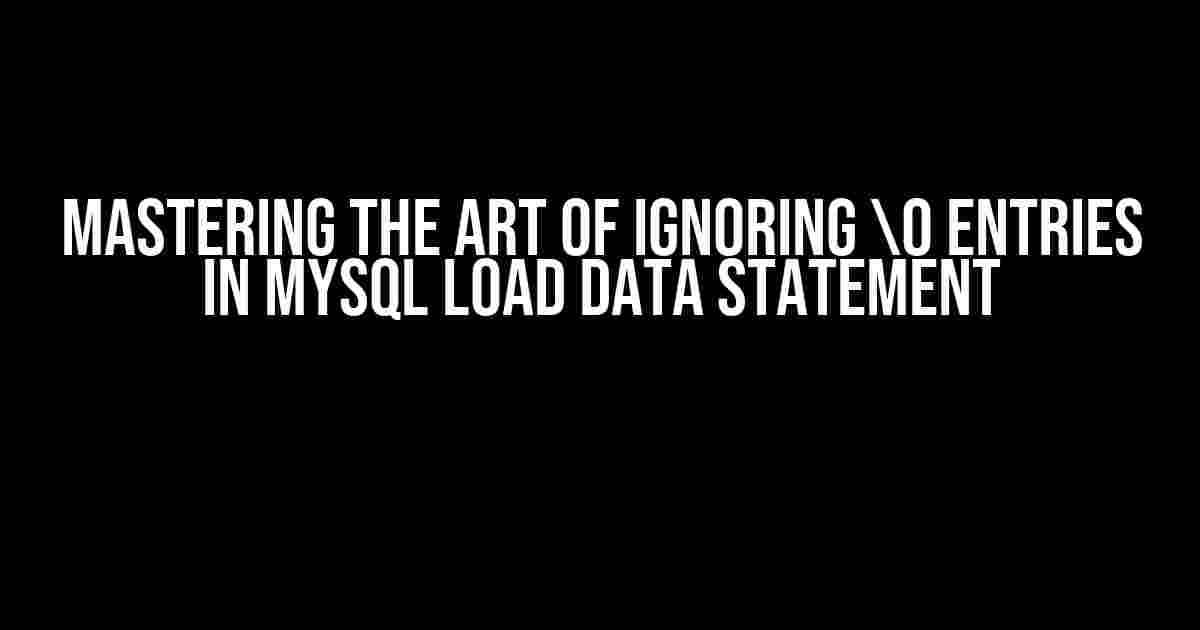If you’re a MySQL enthusiast, you’ve probably encountered the infamous `\0` entries when importing data using the LOAD DATA statement. These pesky null values can wreak havoc on your database, causing importing errors and data inconsistencies. Fear not, dear reader, for today we’ll embark on a journey to conquer the art of ignoring `\0` entries in MySQL LOAD DATA statement.
The Problem with \0 Entries
\0 entries, also known as null bytes, are essentially empty or null values that can be present in your data file. When importing data using the LOAD DATA statement, MySQL may interpret these `\0` entries as legitimate data, leading to errors and inconsistencies. These errors can manifest in various ways, such as:
- Data truncation: MySQL may truncate your data at the point where the `\0` entry is encountered, resulting in incomplete or corrupted data.
- Data corruption: In some cases, MySQL may attempt to insert the `\0` entry as a legitimate value, causing data corruption and errors.
- Import failures: The presence of `\0` entries can cause the entire importing process to fail, leaving you with a incomplete or corrupted database.
Understanding the LOAD DATA Statement
Before we dive into ignoring `\0` entries, let’s take a brief look at the LOAD DATA statement. The LOAD DATA statement is used to import data from a file into a MySQL table. The basic syntax of the statement is:
LOAD DATA [LOW_PRIORITY | CONCURRENT] [LOCAL] INFILE 'file_name' INTO TABLE tbl_name [FIELDS | COLUMNS] [TERMINATED BY ' terminator'] [ENCLOSED BY 'enclosure'] [ESCAPED BY 'escape'] [LINES TERMINATED BY 'line_terminator'] [IGNORE number LINES] [(column_name,...)]
The LOAD DATA statement offers various options to customize the importing process, including:
- LOW_PRIORITY and CONCURRENT: Control the priority and concurrency of the importing process.
- LOCAL: Specify whether the file is located on the client or server.
- FIELDS and COLUMNS: Define the format of the data file.
- TERMINATED BY, ENCLOSED BY, and ESCAPED BY: Specify the characters used to separate, enclose, and escape data values.
- LINES TERMINATED BY: Define the line terminator character.
- IGNORE number LINES: Skip a specified number of lines at the beginning of the file.
- (column_name,…): Specify the columns to be imported.
Ignoing \0 Entries in LOAD DATA Statement
Now that we’ve covered the basics of the LOAD DATA statement, let’s focus on ignoring `\0` entries. There are a few ways to achieve this:
Method 1: Using the IGNORE keyword
The IGNORE keyword can be used to skip lines that contain `\0` entries. You can use the following syntax:
LOAD DATA INFILE 'file_name' INTO TABLE tbl_name IGNORE 1 LINES WITH '\0';
This method is useful when the `\0` entries are present at the beginning of the file. However, if the `\0` entries are scattered throughout the file, this method may not be effective.
Method 2: Using the LINES TERMINATED BY keyword
Another approach is to specify the line terminator character as `\n\0` using the LINES TERMINATED BY keyword:
LOAD DATA INFILE 'file_name' INTO TABLE tbl_name LINES TERMINATED BY '\n\0';
This method tells MySQL to consider the `\0` entry as part of the line terminator, effectively ignoring it.
Method 3: Using a Pre-processing Script
In some cases, the above methods may not be sufficient. You may need to pre-process the data file using a script to remove the `\0` entries before importing the data. Here’s an example of a Perl script that can be used to remove `\0` entries:
#!/usr/bin/perl
use strict;
use warnings;
open(INFILE, "< file_name") or die "Cannot open file: $!";
open(OUTFILE, "> temp_file") or die "Cannot open file: $!";
while (<INFILE>) {
s/\0//g;
print OUTFILE $_;
}
close(INFILE);
close(OUTFILE);
This script reads the original file, removes the `\0` entries, and writes the output to a temporary file. You can then use the temporary file as input for the LOAD DATA statement.
Best Practices for Ignoring \0 Entries
When ignoring `\0` entries in MySQL LOAD DATA statement, it’s essential to follow best practices to ensure data consistency and accuracy:
- Verify data integrity: Before importing data, verify that the data file does not contain any corrupt or incomplete data.
- Test the import process: Test the importing process with a small sample of data to ensure that the IGNORE keyword or line terminator is correctly configured.
- Monitor importing errors: Monitor the importing process for errors and take corrective action if necessary.
- Document the process: Document the importing process and configuration to ensure that future imports are performed consistently.
| Method | Description | Advantages | Disadvantages |
|---|---|---|---|
| IGNORE keyword | Specifies the number of lines to skip at the beginning of the file. | Easy to implement, effective for skipping initial \0 entries. | May not work if \0 entries are scattered throughout the file. |
| LINES TERMINATED BY keyword | Specifies the line terminator character, including \0. | Effective for ignoring \0 entries throughout the file. | May require additional configuration for specific file formats. |
| Pre-processing script | Removes \0 entries from the data file before importing. | Flexible and customizable, effective for complex data files. | May require additional processing time, scripting expertise. |
Conclusion
Ignoring `\0` entries in MySQL LOAD DATA statement is a crucial step in ensuring data consistency and accuracy. By understanding the LOAD DATA statement, using the IGNORE keyword, LINES TERMINATED BY keyword, or a pre-processing script, and following best practices, you can effectively ignore `\0` entries and import data with confidence. Remember, a well-planned importing process is key to a successful database administration.
Now, go forth and conquer the world of MySQL importing, and remember to ignore those pesky `\0` entries!
Frequently Asked Question
Get ready to load your data like a pro! We’ve got the scoop on ignoring those pesky \0 entries in MySQL LOAD DATA statements.
What does the \0 entry represent in a MySQL LOAD DATA statement?
The \0 entry represents a NULL value in a MySQL LOAD DATA statement. It’s usually used to indicate an empty or missing value in a CSV file.
Why do I need to ignore \0 entries in my MySQL LOAD DATA statement?
You need to ignore \0 entries to prevent MySQL from inserting NULL values into your table, which can cause errors or unexpected behavior in your database.
How do I ignore \0 entries in my MySQL LOAD DATA statement?
You can ignore \0 entries by adding the IGNORE keyword to your LOAD DATA statement, followed by the number of lines to skip. For example: LOAD DATA IGNORE 1 LINES …
Will ignoring \0 entries affect the performance of my LOAD DATA statement?
Ignoring \0 entries may have a slight impact on performance, as MySQL needs to skip over the ignored lines. However, this impact is usually minimal and outweighed by the benefits of avoiding errors and inconsistencies in your data.
Can I ignore \0 entries in all types of MySQL files?
No, the IGNORE keyword only works with CSV files. If you’re working with other file types, such as XML or JSON, you’ll need to use alternative methods to handle NULL values.


